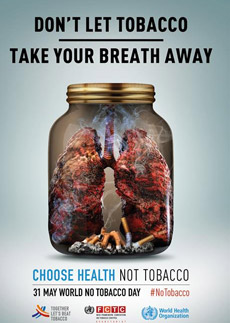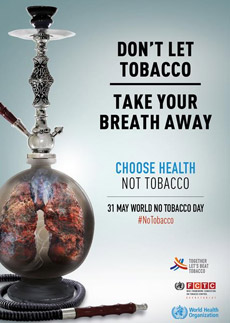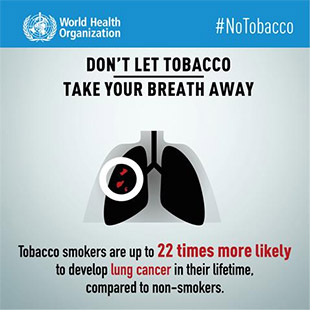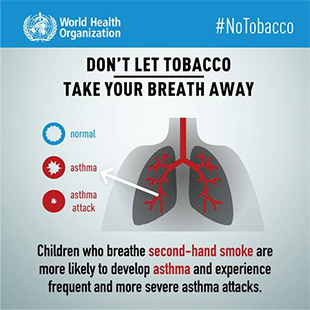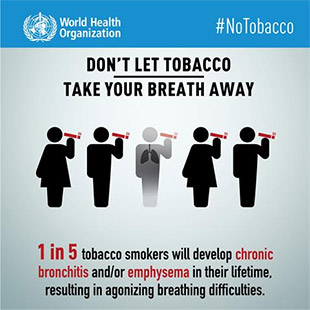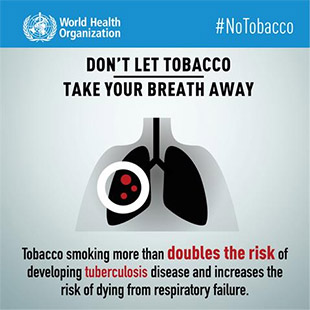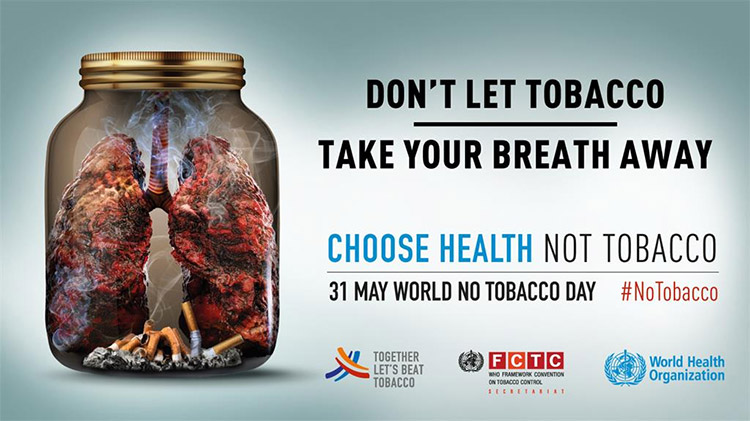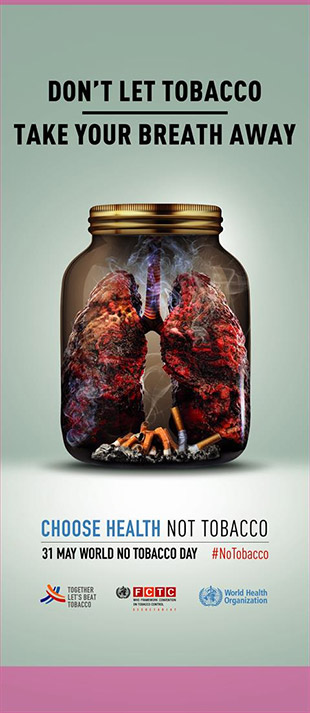Campaign materials
Regional Director's message
This year, World No Tobacco Day focuses on “Tobacco and Lung Health”. Our campaign aims to raise awareness of the harmful effects of tobacco use and second-hand exposure to smoke, discourage the use of tobacco in any form, and promote effective policies to reduce tobacco use.
Tobacco threatens our lung health in many ways. It is a major risk factor for respiratory diseases, which are a leading cause of death and suffering among people of all ages, in all the different regions of the world, including our own Eastern Mediterranean Region. Moreover, tobacco smoke contributes to indoor air pollution, which is a major threat to lung health. All the major respiratory diseases are caused by tobacco smoking and exposure to second-hand smoke, but the leading causes of death and disability are lung cancer, chronic obstructive pulmonary disease, tuberculosis and asthma.
In short, tobacco is taking your breath away one way or another. Don’t let it. With just one breath, you open yourself up to thousands of toxins from the tobacco smoke which begin damaging your lungs immediately. You become breathless and your lung function is reduced. The same happens with infants, children and adolescents. During pregnancy, second-hand smoke can lead to reduced lung growth and function. Parents who smoke around their children put them at risk of developing chronic respiratory disorders as they grow older. Adolescents who smoke are more likely to develop chronic respiratory disorders and risk permanently damaging their lungs.
The only solution is to stop tobacco from taking your breath away. Tobacco kills one person every four seconds. Do not be that person and do not contribute to the death toll. I say this because tobacco use in the Eastern Mediterranean Region is alarming. In some of our countries, as many as 57% of men and 29% of women smoke. Smoking among young people is particularly worrying, reaching 42% in boys and 31% in girls. This includes smoking shisha, which is more popular among young people than cigarettes. By 2025, smoking is expected to rise in this Region, contrary to the trend in the rest of the world. This will lead to an escalating epidemic of lung disease regionally.
So let us beat tobacco and improve lung health and the overall health and well-being of people in our Region.
As individuals, you can beat tobacco by kicking the habit and not lighting up in the first place.
As governments, you can beat tobacco by implementing the WHO Framework Convention on Tobacco Control and adopting the MPOWER measures to reduce the demand for tobacco. That means: creating smoke-free indoor public places; banning tobacco advertising, promotion and sponsorship; significantly increasing taxes on tobacco products; requiring pictorial health warnings on all tobacco products; providing cessation services to help people quit; and monitoring tobacco use and prevention policies. If you comprehensively implement the WHO Framework Convention on Tobacco Control and the MPOWER measures to reduce tobacco use in the Region, you can reduce tobacco use by between 20% to 40% in 5 years, and 56% in 15 years.
As our partners, you can beat tobacco by advocating for the effective enforcement of these policies and helping us engage other stakeholders across different sectors.
We have all made a commitment to reduce tobacco use by 30% by 2025. On this World No Tobacco Day, let us work together to achieve our target, beat tobacco, and stop it from taking our breath away.
Brochure
Posters
|
|
Don’t let tobacco take your breath away - Quit now and say no to second-hand smoke
Videos
Social media tiles
|
|
|
Web banner
Rollup
Campaign messages
If you are organizing an activity, or developing your own campaign materials, here are some facts and figures that you might want to use:
More than 7 million people die from tobacco use every year, including the 900 000 people that die from exposure to secondhand smoke. This translates into more than 19 000 people dying every day from tobacco use or second-hand smoke.
Some 80% of premature deaths from tobacco occur in low- or middle-income countries, which face increased challenges to achieving their development goals.
In some countries of the Eastern Mediterranean Region, smoking can be as high as 52% among men and 22% among women. Data for young boys and girls are equally alarming. Smoking can reach 42% among boys and 31% among girls.
Tobacco has a negative impact on people’s lung health, from cancer to chronic respiratory disease.
Tobacco smoking is the primary cause for lung cancer, responsible for over two thirds of lung cancer deaths globally.
Second-hand smoke exposure at home or in the work place also increases risk of lung cancer.
Tobacco smoking is the leading cause of chronic obstructive pulmonary disease (COPD), a condition where the build-up of pus-filled mucus in the lungs results in a painful cough and agonising breathing difficulties.
The risk of developing COPD is particularly high among individuals who start smoking at a young age, as tobacco smoke significantly slows lung development.
Tobacco exacerbates asthma, which restricts activity and contributes to disability.
Tuberculosis damages the lungs and reduces lung function, which is further exacerbated by tobacco smoking.
Tobacco smoke is a very dangerous form of air pollution.
Tobacco smoke contains over 7000 chemicals, 69 of which are known to cause cancer.
Quitting smoking can reduce the risk of lung cancer, slows the progression of COPD and improves asthma symptoms.
The WHO FCTC guides the global fight against the tobacco epidemic. It is an international treaty with 180 Parties.
Today, more than half the world’s countries, representing nearly 40% of the world’s population (2.8 billion people), have implemented at least one of the WHO FCTC’s most cost-effective measures to the highest level. An increasing number of countries are creating firewalls to ward off interference from the tobacco industry in government tobacco control policy.
The comprehensive implementation of the WHO FCTC and the MPOWER measures to reduce tobacco use in the Eastern Mediterranean Region would lead to a reduction in tobacco use ranging from 20% to 40% in 5 years and, in some countries, by up to 36% in 5 years and 56% in 15 years.
How you can get involved
Use and adapt our campaign materials
We are developing a number of campaign materials. Versions of these materials will be available in Arabic, English and French, and can be freely downloaded as soon as they become available.
Disseminate the materials
Think about where campaign materials can be made available to reach people for whom they are intended. A few ideas are: health care centres, clinics, hospitals, schools, colleges and universities, supermarkets, leisure and social clubs, associations, places of work, places of worship, and public transport.
Organize an activity
Organizing an activity or event is a great way to raise awareness about tobacco and stimulate action, both among individuals, and on a wider scale. If you do decide to organize an event, keep in mind the following:
What are you trying to achieve?
Who are you targeting?
What would make your target audiences want to participate?
When and where will your activity be held?
Should you join up with other organizations?
Who will you invite? Are there any well-known figures who could help you achieve your goals?
Do you have the resources to achieve your goals? If not, how can you mobilize them?
How will you promote your event?
Can the media help you achieve your goals? If so, which media should you target?
How will you share information about your activities after the event?
How will you measure success?
Examples of activities that you might want to consider are: discussion forums, sporting events, workshops for journalists, art competitions, coffee mornings, concerts, sponsored activities ̶ anything that contributes to a better understanding of tobacco control.
Think about involving your organization’s champions, especially if they are influential among those you are trying to reach.
While this is a one-year campaign, and as such, activities can be organized throughout the year, we encourage you to consider starting your activities on World No Tobacco Day, 31 May 2019. Media attention is high on this day, which can generate greater awareness.
Share information and materials on social media
Throughout the campaign, we will be communicating via our social media channels. The primary hashtag that we are using for the campaign is #NoTobacco. We encourage you to share our posts with your own networks, share your own materials and join discussions on issues related to the campaign.
Please note that WHO-branded materials should be used as is.
For questions on use of the materials, please send an email to Ms Nisreen Abdel Latif, WHO Communications,


